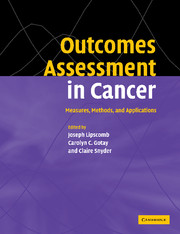Book contents
- Frontmatter
- Contents
- List of contributors
- Acknowledgments
- 1 Introduction to Outcomes Assessment in Cancer
- Health-related quality of life in cancer: general concepts and generic measures
- Assessing health-related quality of life during treatment
- 5 Quality of life in breast cancer: what have we learned and where do we go from here?
- 6 Measuring quality of life in prostate cancer: progress and challenges
- 7 The science of quality-of-life measurement in lung cancer
- 8 Treatment for colorectal cancer: impact on health-related quality of life
- 9 Instruments to measure the specific health impact of surgery, radiation, and chemotherapy on cancer patients
- Assessing health-related quality of life across the cancer continuum
- Measuring the experience and needs of cancer patients and caregivers
- Methodological considerations in applications to cancer outcomes research
- Modern psychometric theory in cancer outcomes research
- Assessing the economic impact of cancer
- Research and policy implications
- Invited papers
- Index
- References
6 - Measuring quality of life in prostate cancer: progress and challenges
Published online by Cambridge University Press: 18 December 2009
- Frontmatter
- Contents
- List of contributors
- Acknowledgments
- 1 Introduction to Outcomes Assessment in Cancer
- Health-related quality of life in cancer: general concepts and generic measures
- Assessing health-related quality of life during treatment
- 5 Quality of life in breast cancer: what have we learned and where do we go from here?
- 6 Measuring quality of life in prostate cancer: progress and challenges
- 7 The science of quality-of-life measurement in lung cancer
- 8 Treatment for colorectal cancer: impact on health-related quality of life
- 9 Instruments to measure the specific health impact of surgery, radiation, and chemotherapy on cancer patients
- Assessing health-related quality of life across the cancer continuum
- Measuring the experience and needs of cancer patients and caregivers
- Methodological considerations in applications to cancer outcomes research
- Modern psychometric theory in cancer outcomes research
- Assessing the economic impact of cancer
- Research and policy implications
- Invited papers
- Index
- References
Summary
Introduction
The potential for health-related quality of life (HRQOL) assessment to edify prostate cancer research and improve patient care is exceptional, but its application is recent and evolving rapidly. While breast cancer patients have been subject to HRQOL evaluation since the early 1980s, sophisticated studies of prostate cancer patient-reported HRQOL began appearing only a decade ago. The goal of this chapter is to survey the published record of HRQOL studies in prostate cancer, describe the most commonly used instruments and how they have performed, as well as some recently described instruments, and to sketch some potentially useful future research directions.
Continuum of care
The diagnosis and management of prostate cancer, the most common non-cutaneous malignancy and the second leading cause of cancer death in American men, are uniquely controversial among human malignancies. Many groups advocate forcefully for widespread screening of asymptomatic men with the prostate-specific antigen (PSA), while many others argue just as strongly for restraint. Once diagnosed, prostate cancer may be managed with qualitatively different treatment modalities or initial observation (“watchful waiting”), but the virtual absence of data from randomized clinical trials makes the treatment decision-making process frustrating for patients, while physicians often struggle to provide the most helpful advice. The clinical management of recurrent cancer is also subject to controversy which parallels that for early disease: PSA technology allows identification of tumor progression years before symptoms of cancer emerge, if ever, and the toxicity of treatment options at that stage is important and increasingly evident.
- Type
- Chapter
- Information
- Outcomes Assessment in CancerMeasures, Methods and Applications, pp. 126 - 159Publisher: Cambridge University PressPrint publication year: 2004
References
- 1
- Cited by



